This post contains affiliate links, which means I may earn a commission if you purchase through those links (at no extra cost to you).
If you love pickles and you love garlic, this pickled garlic recipe is super simple to make and keeps in the refrigerator for a few months! Not suitable for canning.
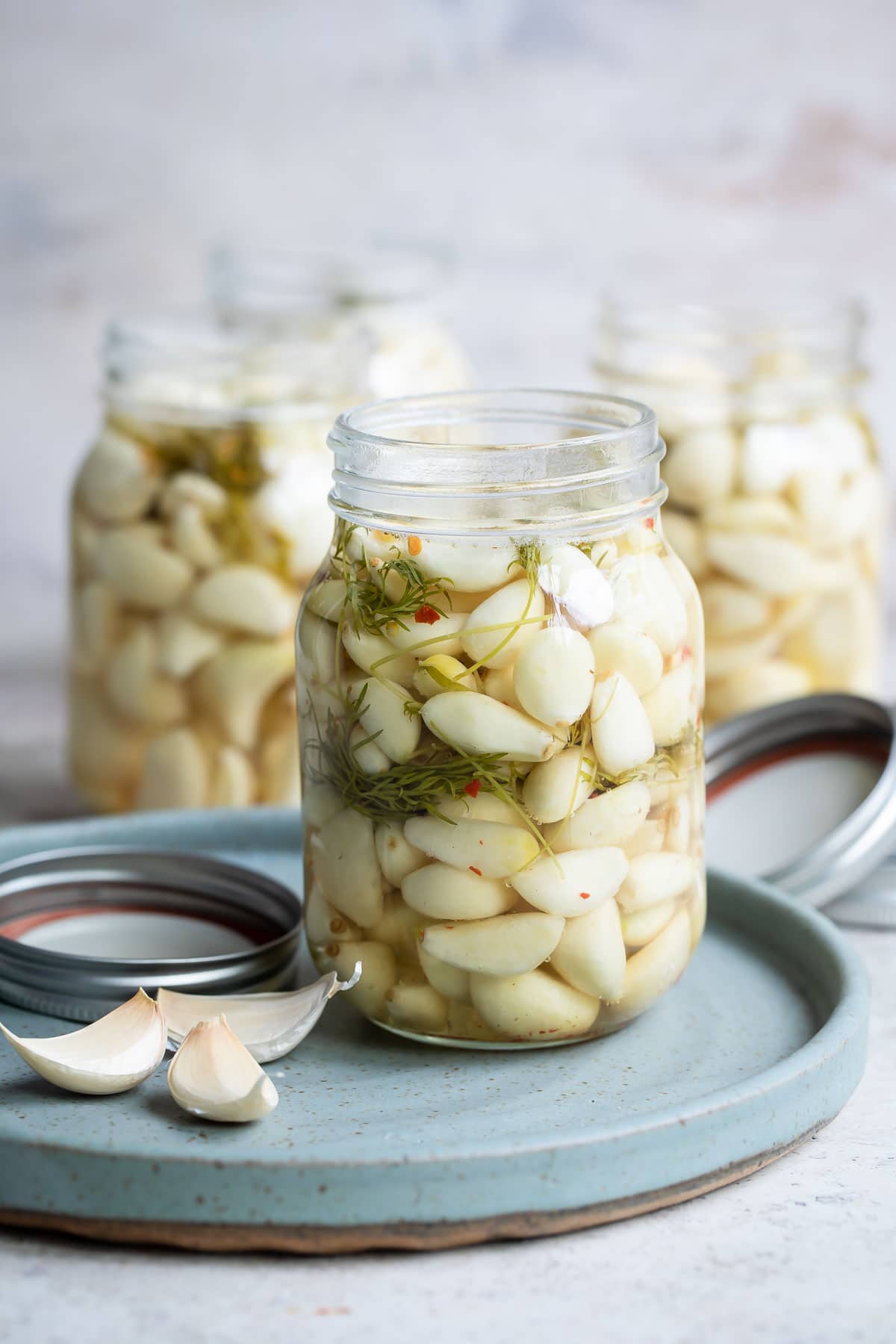
Several years ago, I was discussing Dilly Beans with my mother-in-law. She made them for a church fundraiser, and she was planning to set aside a jar for me as a Christmas gift. Would I like a clove of garlic in my jar of Dilly Beans?
My response? “Could I please have a whole jar of Dilly Garlic?” I’m so grateful she agreed!
Recipe ingredients
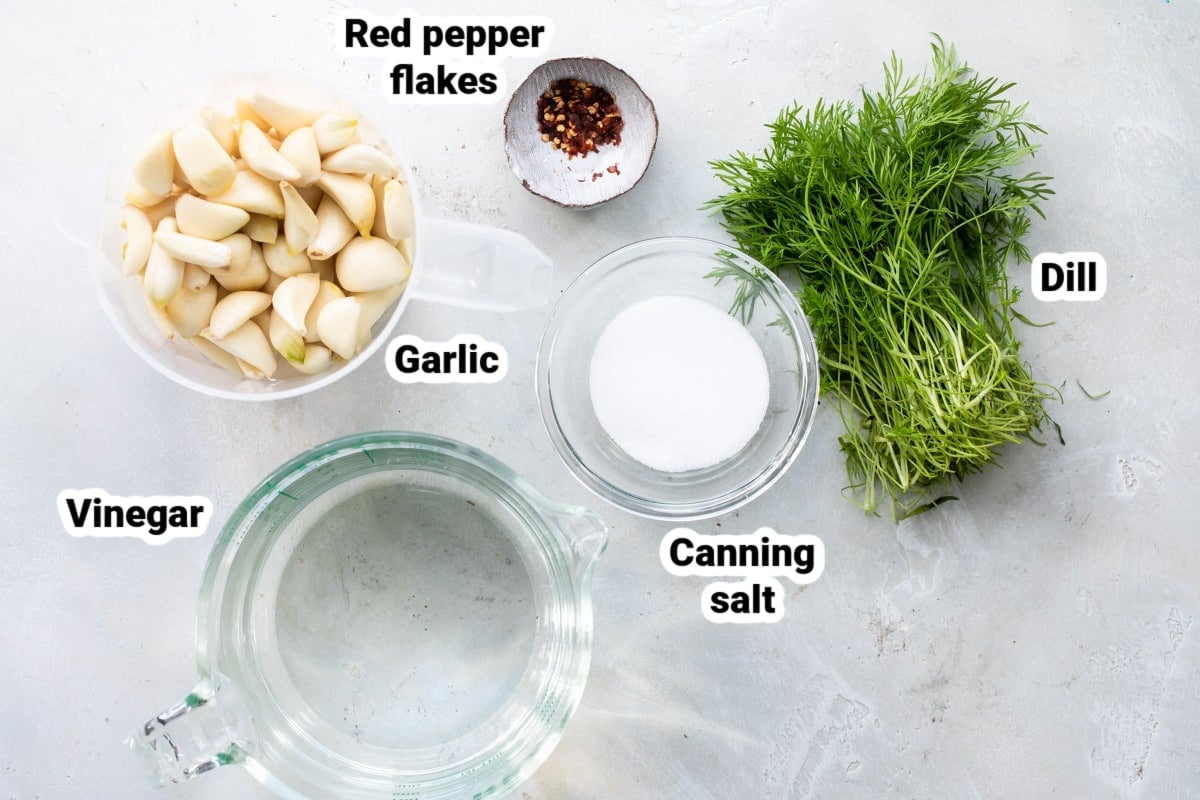
At a Glance: Here is a quick snapshot of what ingredients are in this recipe.
Please see the recipe card below for specific quantities.
Ingredient notes
- WARNING: This recipe is not suitable for shelf-stable canning. Obviously people (or companies) sell shelf-stable pickled garlic, but I am not an expert in this area and garlic has a propensity to develop botulism. So, if you make this recipe, you MUST store it in the refrigerator. Even if you seal the jars with a water bath. Refrigerate! “Canning of garlic is not recommended. Garlic is a low-acid vegetable that requires a pressure canner to be properly processed. Garlic loses most of its flavor when heated in this way. For this reason, adequate processing times have not been determined for canning garlic.”
Step-by-step instructions
- Combine canning salt and vinegar in a large saucepan. Bring to boil; reduce heat and simmer 10 minutes (180 degrees). Meanwhile, pack garlic into 4 sterilized pint jars (about 8 ounces per jar) leaving 1/2-inch of headspace. Add ¼ teaspoon red pepper flakes and 1 head of dill to each jar. (If using fresh dill, add ½ cup to each jar.)

- Using a ladle, divide hot pickling liquid between the 4 jars, leaving 1/2-inch of headspace. Remove air bubbles, clean jar rims, center lids on jars, and adjust band to fingertip-tight.
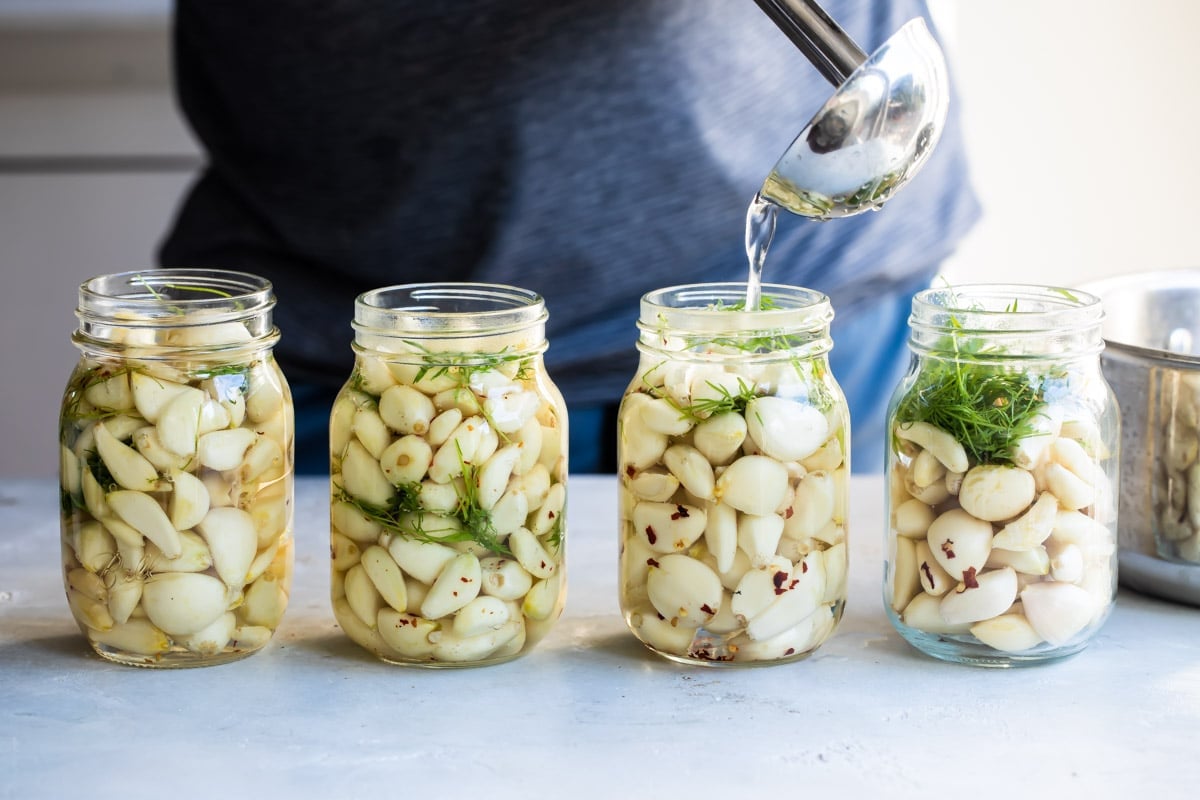
- Chill in the refrigerator until pickled as desired (I recommend at least 3 weeks in the refrigerator). Store in refrigerator for up to 4 months (see notes) or seal jars following the instructions below (the pickled garlic must still be refrigerated; it will not be shelf-stable).
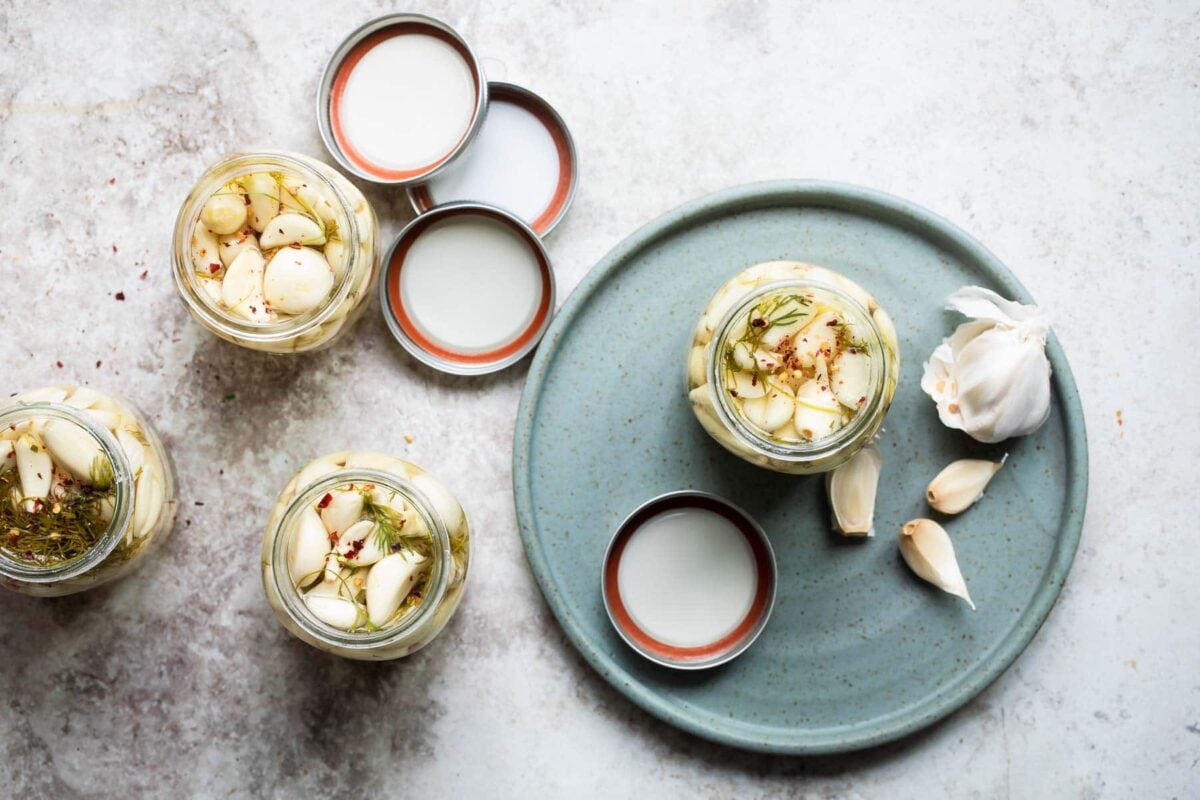
Recipe tips and variations
- Yield: This recipe makes 4 pints (8 cups), enough for 32 servings, ¼ cup each.
- Storage: The National Center for Home Food Preservation states that the garlic and vinegar mixture may be refrigerated for up to 4 months. It’s safe to use the flavored liquid for other things. Discard if you see any signs of mold or yeast growth.
- Blue garlic: Sometimes pickled garlic turns blue or turquoise when you pickle it. It’s completely normal and still safe to eat and you don’t need to worry. You can read all about the chemistry of garlic (and exactly why it may or may not turn blue). To prevent the bluish color:
- User kosher salt or sea salt to avoid iodine
- Use stainless steel or enamel cookware and utensils (avoid copper, aluminum, cast iron, and tin cookware and utensils)
- Reduce chlorophyll production by avoiding sunlight
- Use distilled water to avoid the trace minerals found in tap water
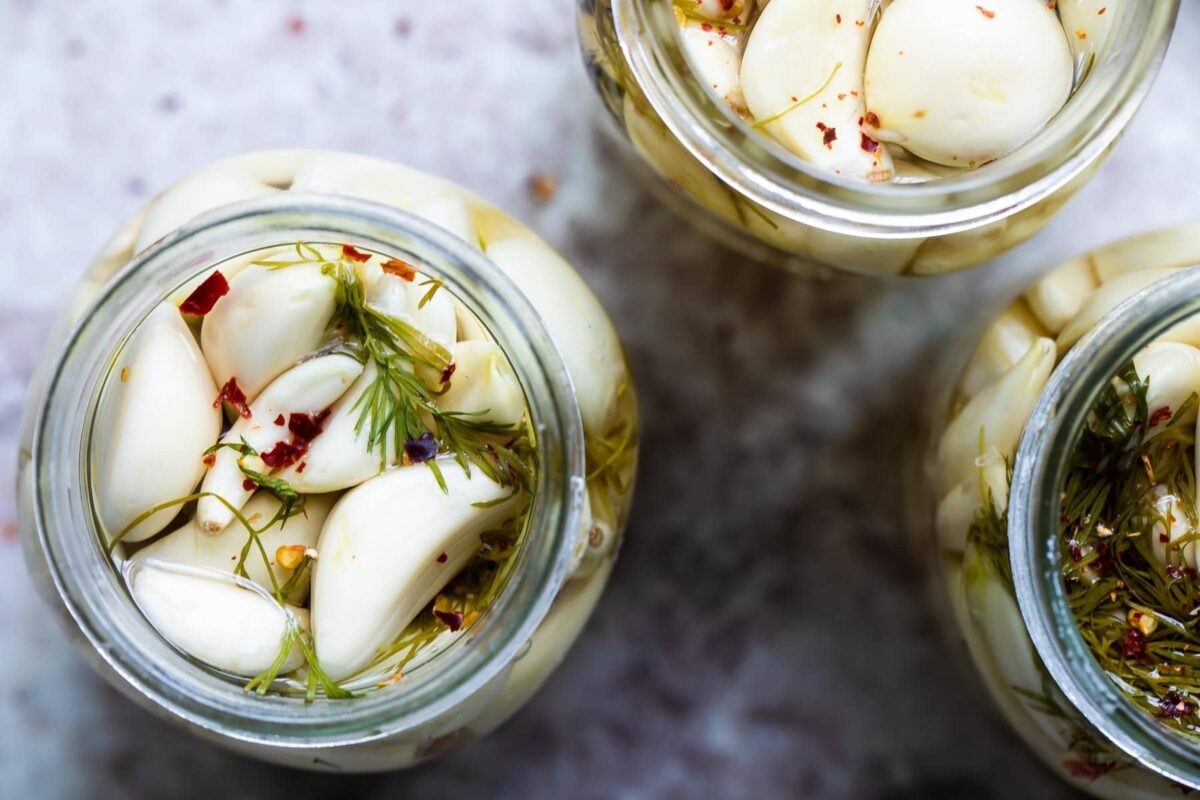
Bloody Mary Bar
Lazy weekends and holiday mornings call for a Bloody Mary Bar with homemade mix and all the savory pickled stuff you can find. It’s a total crowd-pleaser; from the purists to the meal-in-a-glass folks, everyone…
View RecipePut your pickled garlic to work
Entertaining
Midwest Charcuterie Board
Italian Recipes
Antipasto Platter
Appetizer Recipes
Jarcuterie
Appetizer Recipes
Ham Roll Ups
Join Us
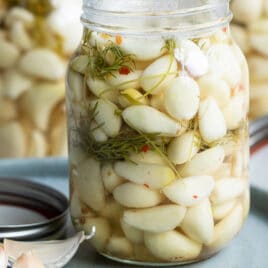
Pickled Garlic
Equipment
Ingredients
- 1/4 cup canning salt
- 5 cups white vinegar
- 2 pounds fresh garlic peeled
- 1 teaspoon red chili flakes
- 4 heads fresh dill or 2 cups fresh, stems and leaves coarsely chopped
Instructions
- Combine canning salt and vinegar in a large saucepan. Bring to boil; reduce heat and simmer 10 minutes (180 degrees).
- Meanwhile, pack garlic into 4 sterilized pint jars (about 8 ounces per jar) leaving 1/2-inch of headspace. Add ¼ teaspoon red pepper flakes and 1 head of dill to each jar. (If using fresh dill, add ½ cup to each jar.)
- Using a ladle, divide hot pickling liquid between the 4 jars, leaving 1/2-inch of headspace. Remove air bubbles, clean jar rims, center lids on jars, and adjust band to fingertip-tight.
- Chill in the refrigerator until pickled as desired (I recommend at least 3 weeks in the refrigerator). Store in refrigerator for up to 4 months (see notes) or seal jars following the instructions below (the pickled garlic must still be refrigerated; it will not be shelf-stable).
To seal jars (MUST BE REFRIGERATED, NOT SHELF-STABLE):
- Process jars in boiling water for 10 minutes. The jars must be covered by at least 1 inch of water. Turn off heat and remove cover. Let jars cool 5 minutes. Cool 12 hours. Check seals. Chill in the refrigerator until pickled as desired (I recommend at least 3 weeks in the refrigerator). Store in refrigerator for up to 4 months (see notes).
Recipe Video
Notes
- WARNING: This recipe is not suitable for shelf-stable canning. Obviously people (or companies) sell shelf-stable pickled garlic, but I am not an expert in this area and garlic has a propensity to develop botulism. So, if you make this recipe, you MUST store it in the refrigerator. Even if you seal the jars with a water bath. Refrigerate! “Canning of garlic is not recommended. Garlic is a low-acid vegetable that requires a pressure canner to be properly processed. Garlic loses most of its flavor when heated in this way. For this reason, adequate processing times have not been determined for canning garlic.”
- Yield: This recipe makes 4 pints (8 cups), enough for 32 servings, ¼ cup each.
- Storage: The National Center for Home Food Preservation states that the garlic and vinegar mixture may be refrigerated for up to 4 months. It’s safe to use the flavored liquid for other things. Discard if you see any signs of mold or yeast growth.
- Blue garlic: Sometimes pickled garlic turns blue or turquoise when you pickle it. It’s completely normal and still safe to eat and you don’t need to worry. You can read all about the chemistry of garlic (and exactly why it may or may not turn blue). To prevent the bluish color:
- User kosher salt or sea salt to avoid iodine
- Use stainless steel or enamel cookware and utensils (avoid copper, aluminum, cast iron, and tin cookware and utensils)
- Reduce chlorophyll production by avoiding sunlight
- Use distilled water to avoid the trace minerals found in tap water.
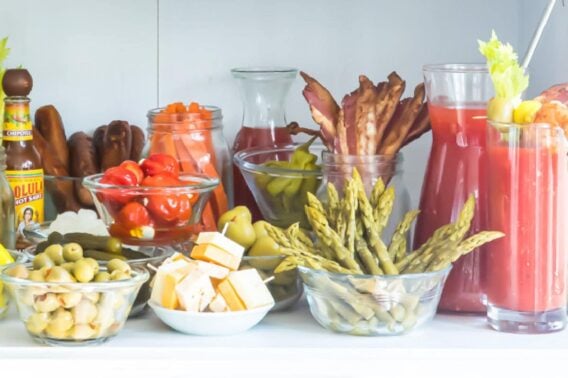

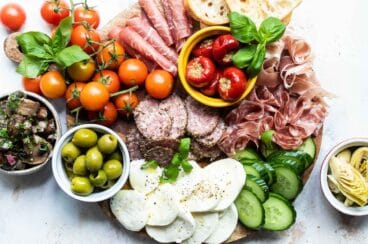
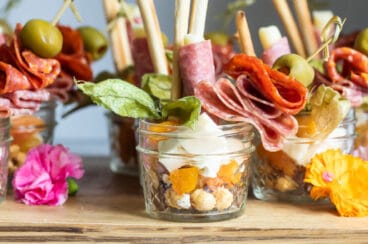
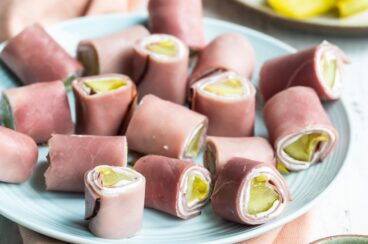
Meggan, I grow Garlic quite a lot actually and can maybe help out with Bruce’s question.
I was reading and maybe you did not fully understand, or maybe I did not. But I am hopelessly helpful so here goes.
Under the garlic skin is a membranes you can peel also. Tricky to get off, I use water bath and this helps. It also helps getting the skin off as the water gets under it easily and them the skins come right off. Simply put your cloves in a bowl with water 3-5 minutes and your ready to peel.
Hope this helps you and all others reading your recipes. Thanks
Meggan, on the above post from Bruce You misunderstood his question about the inner what he called papery layer.
I grow this stuff and this layer he is referring to is a membrane, super thin and sometimes difficult to remove.
So if I may, you can remove this sometimes by washing. This also how I peel my garlic (simply place cloves in a bowl of water for a few minutes) as the MS way really is only effective on store bought product. If you buy the fresh and good garlic that folks grow locally it will really not peel this way unless it is very old and then it is of course not fresh (what is very old) more than a year. Which is how old your store product is as they store it in zero oxygen or zap it with radiation if it is from certain places! Hope this helps!
Only wanna remark that you have a very nice web site, I like the layout it actually stands out.
Hi Peni, wow thank you so much! That’s really nice of you to say! I appreciate you. Thanks again.
I have a friend who put their batch in smaller jars and added more dill than the recipe. Would this cause the garlic to turn green
When you peal the garlic do you take the final thin papery layer off to so it’s down to the fleshy part of the clove? Other recipes I’ve looked up have you leaving it on and others don’t say. Seems like you would want that layer off.
Hi Bruce, thanks for the question! In my recipe, you take the paper off and just use the fleshy part. For me, this is so I can just take the garlic out of the jar and eat it immediately (no peeling required). Also, the garlic I see from the store has the paper off. So, I’d definitely remove it! I cannot think of a benefit to leaving it on. Thanks!
Thank you Meggan. I was thinking the same thing. Just wanted to check.
How do you remove the air bubbles?
Love how sites like this pick and chose what questions to answer although the logic escapes me. Either it was a stupid or you don’t know the answer? Why would you bypass a question and go to the next?
Hi Brenda, I’m really sorry about that! I get a lot of comments and sometimes one slips through the cracks. Let me look into this because I don’t immediately know what you mean or the answer. But, I will get back to you! Didn’t mean to ignore you. Thanks.
Hi Brenda,
You can tap the jars, or use something long and narrow like a skewer to reach in between the garlic and release any air trapped between them.
Lori! You saved me! Thank you so much. I appreciate you getting back to Brenda while I 1). Missed her question and then 2). Was traveling over the weekend. I appreciate you so much! Thanks again.
This is not a safe recipe for canning. Garlic is low PH, you can make it but it must be stored in the refrigerator.
http://ucfoodsafety.ucdavis.edu/files/250352.pdf
Thanks for this, Samantha! I agree with you. I’ve obviously had this canned and haven’t had any problems, but the risk is clearly there. I’ll update the recipe to reflect this info. I really appreciate that you dropped the link for me!
Meegan,
not seeing the recipe be changed. Canning garlic is not safe, you can store in fridge, but not shelf stable for long term storage. Sorry, not trying to be food police, but I’m a certified food preserver and don’t want people getting sick from preserved food.
Hi Samantha,
I really appreciate you coming back and letting me know. I am grateful you took the time to do that, and I completely understand why. I’ve updated the recipe and notes. Thank you again.
Meegan,
Thank you for updating the info, you rock!
The Ball Blue Book has a recipe for pickled garlic that is canned and not refrigerated. That book is what I go by. FYI
How long do you let your garlic sit before you can eat them. I’ve been trying to pickle garlic for years but it never turns out. I’ve had them turn blue and go to mush. I’ve also had them go so strong that they turn your stomach. I’m going to try this recipe.
Nicole, the blue color is just a chemical reaction, it’s still edible. However, it must be stored in the fridge, not safe for long term storage or canning it for the shelf.
looks great!! we used to make our own half sour pickles at my coffee shops! It was awesome cause we got MASSIVE pickles, I mean huge buggers, from a local farm and pickles them whole in buckets. Love garlic so I bet these are right up my ally
Too bad we don’t live closer. I’ve got 20 quarts of organic dilly beans. I’ll have to try this on a pint.
One note, if you can stand it, let them sit for 3-5 weeks to mature and achieve their full flavor.